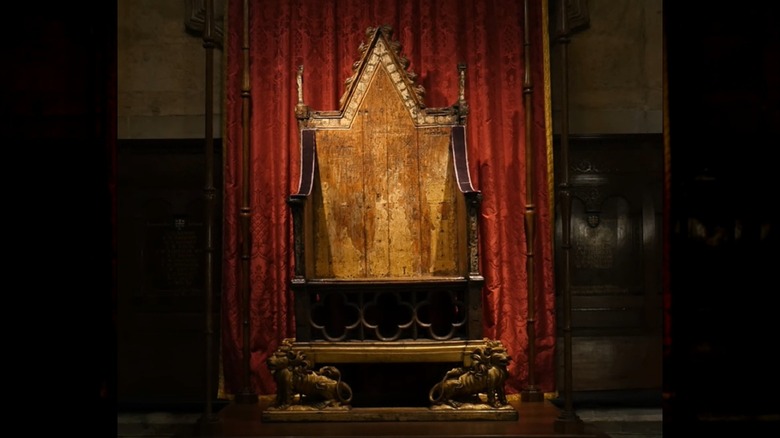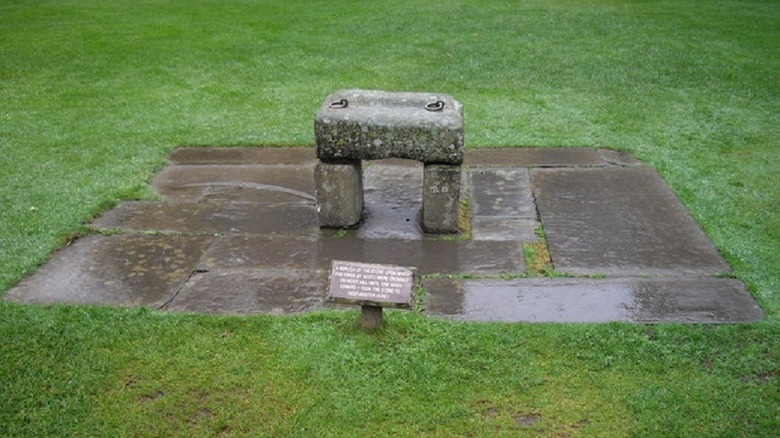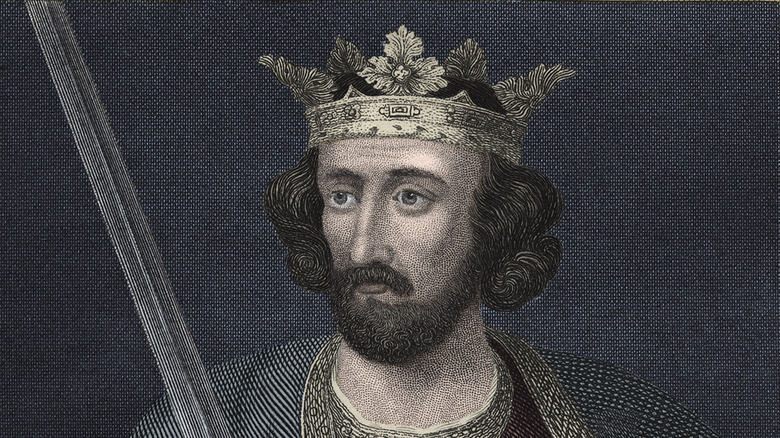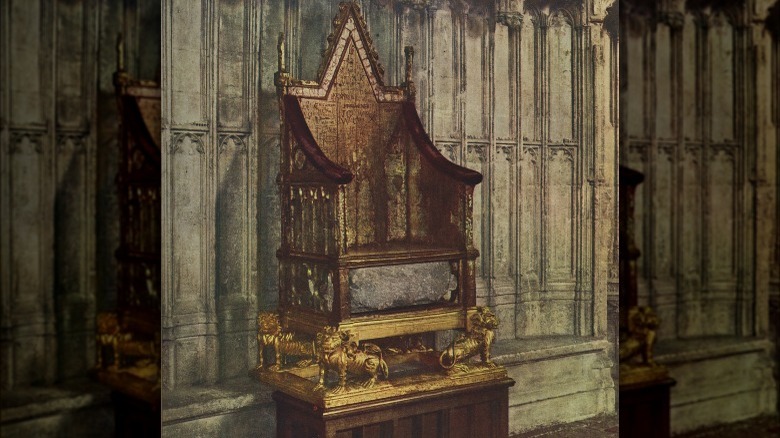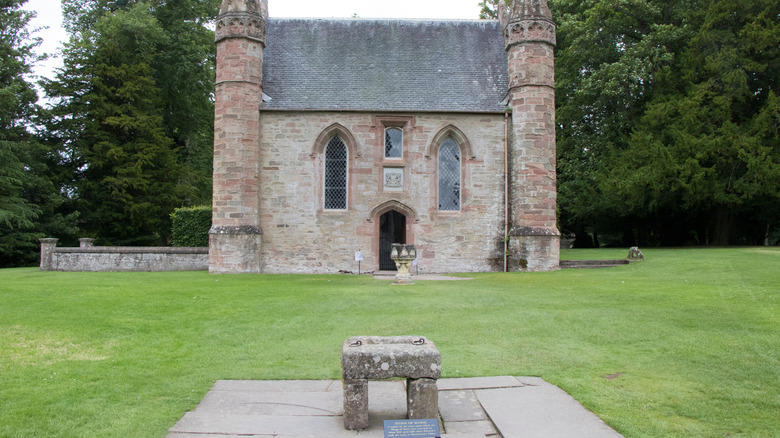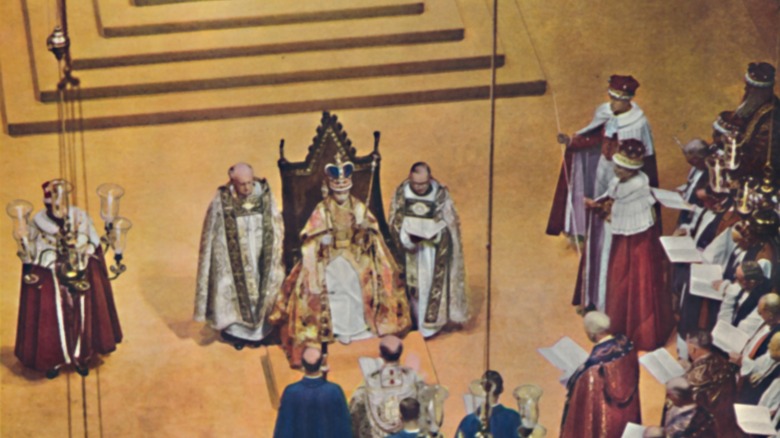The Coronation Chair Has A Shady Past
The coronation ceremony of a British monarch is steeped in tradition. Its purpose, apart from celebration, is for the new monarch to formally take an oath to rule with wisdom, honor, and mercy. There is also a religious aspect to the ceremony, and an archbishop anoints the monarch with holy oil (via Royal). A ring, orb, sword, scepter, and crown — known collectively as the British Crown Jewels — are then presented to the monarch to symbolize the sovereign's power.
Another longstanding tradition during coronation ceremonies is the use of the Coronation Chair, known historically as King Edward's Chair or St. Edward's Chair. As noted by Westminster Abbey, the Coronation Chair has been used in coronations for more than 700 years and is one of the most treasured pieces of furniture in the world. All crowned monarchs since the 14th century used the coronation chair, except for Queen Mary II, who was crowned using a copy of the chair.
The Stone of Scone
The Coronation Chair itself is made of timber, but underneath the seat is a rectangular space to hold the Stone of Scone (replica above), also called the Stone of Destiny. The large block of stone, as noted by Edinburgh Castle, is a sacred object to the Scottish sovereign. Its origins are unknown but legend says that it's the same stone that Jacob used as a pillow in the Book of Genesis wherein he had a dream about a stairway to heaven. According to Britannica, the Stone of Scone was supposedly transported from Egypt and traveled to various locations before it reached Ireland in 700 B.C. where it was used for the coronation of monarchs. The Stone of Scone is made of yellow sandstone — most likely of Scottish origin — and weighs 336 pounds. It measures 26 inches long, 16 inches wide, and 11 inches high.
In 1296, King John Balliol of Scotland signed a treaty with France instead of providing aid to King Edward I in his war against the French. This caused King Edward I to wage war against the Scots in what is historically known as the Battle of Dunbar (via BBC). King Edward I triumphed and seized the Stone of Scone from the Scone Abbey and had it brought back to Westminster Abbey together with the Scottish crown and scepter.
The creation of the Coronation Chair
King Edward I, known as the Hammer of the Scots, ordered the creation of the Coronation Chair in the early 14th century in order to hold the Stone of Scone. For him, it also symbolized that future monarchs of England will also be crowned as rulers of Scotland. Initially, King Edward I wanted the chair to be made of bronze. However, before it was done, the king decided that he instead wanted it to be made of timber. As reported by The Past, the chair was constructed using oak and for a time was called King Edward's Chair; it wasn't until recent times that it was referred to as the Coronation Chair.
After it was made, King Edward's Chair served as a seat for priests during masses. It isn't known when the chair was first used in a coronation ceremony, but Henry IV used it when he was crowned in 1399. However, there is an illustration of King Edward II that shows him sitting on what appears to be the Coronation Chair in 1308. Since then, all crowned monarchs used the chair during their coronation ceremony, save for Queen Mary II. In 1689, King William III and Mary II began their reign as co-monarchs. According to the University of Illinois, King William III sat on the Coronation Chair during the ceremony, while a different chair was constructed beforehand for Queen Mary II to use.
The original design of the chair and restorations
According to Stuff About London, the original craftsman of the Coronation Chair was a man only known as Master Walter of Durham. Originally, a portrait of a king was placed on the back of the chair, and it was painted with animals and foliage. The panels had colors glass with gilded decorations, and the chair's arms were decorated with carvings of lions. The first few monarchs who used the chair sat directly on the Stone of Scone, but a seat was added in the 17th century.
The Coronation Chair suffered abuse throughout the years. The paintings faded, the glasswork was lost, and parts of the chair were covered in graffiti. The book "The Coronation Chair and Stone of Scone," details how the chair was damaged by a bomb in 1914, and it was also stolen and damaged in 1950. In 2010, the Coronation Chair was extensively restored in order to preserve the original details. In an interview with the Yorkshire Post, Dr. Tony Trowles of the Abbey Collection said, "It's a slightly battered object but what does survive is particularly fragile and needs to be stabilized."
The Stone of Scone was eventually returned to Scotland
In 1328, Scotland and England signed the Treaty of Northampton, which recognized Scotland's independence. During that time, England also promised to return the Stone of Scone. However, riots broke out and per World History, the Abbot of Westminster Abbey allegedly didn't want it returned to Scotland. It would take several more centuries before the Stone of Scone would be returned from where it was taken.
In 1996, after plenty of discussions, England finally announced that it would be returning the Stone of Scone to Scotland. As reported by BBC, the slab of stone was transported via a train and then driven to its destination at Edinburgh Castle with police escort. The whole process took six hours to complete, as the removal of the stone from the Coronation Chair had to be meticulously noted for when it is needed for a coronation. Today, the Stone of Scone is safeguarded in Perth, Scotland, a few miles away from the town of Scone where it was taken.
Where is the Coronation Chair kept?
For centuries, the Coronation Chair was kept in the Chapel of St. Edward the Confessor until the chapel was closed to the public in 1997. The following year, the Coronation Chair was transported to Westminster Abbey. Today, it is kept on a secure pedestal in St. George's Chapel by the tomb of Henry V (via Westminster Abbey). The only time the Coronation Chair is removed from its spot is for the crowning ceremony of a new monarch where it will be carried to the Abbey's High Altar in the coronation theater.
For future coronations, Scotland will lend the Stone of Scone to be used for coronation ceremonies, and it will be inserted into the empty space underneath the Coronation Chair. The Coronation Chair is considered the oldest piece of furniture in the United Kingdom that is still used for its intended purpose. Visitors can get a glimpse of the Coronation Chair during a tour of Westminster Abbey.
